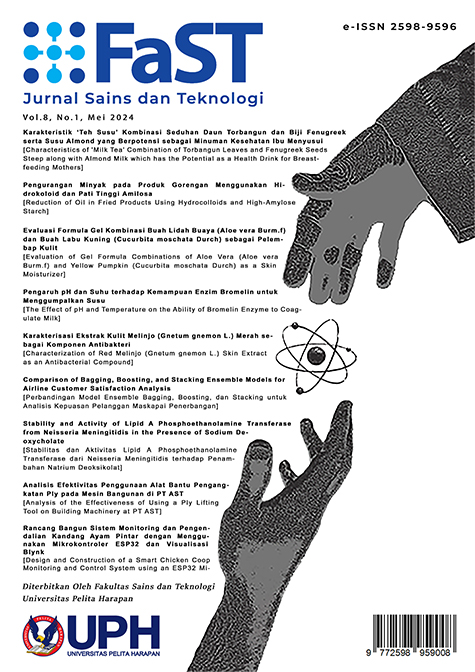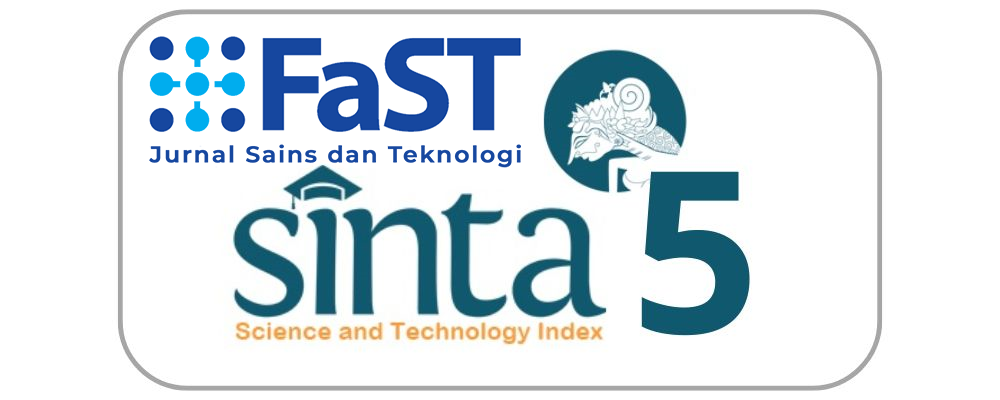PENGURANGAN MINYAK PADA PRODUK GORENGAN MENGGUNAKAN HIDROKOLOID DAN PATI TINGGI AMILOSA [REDUCTION OF OIL IN FRIED PRODUCTS USING HYDROCOLLOIDS AND HIGH-AMYLOSE STARCH]
DOI:
https://doi.org/10.19166/jstfast.v8i1.8261Keywords:
fried products, high amylose starch, hydrocolloids, oil uptakeAbstract
Consumption of high-fat fried products and high oil absorption in fried products can lead to health problems. The oil absorption can be reduced by utilizing hydrocolloids and high amylose starch as coating materials in foo products. The purpose of this study was to determine the best formulation of coating dough (high amylose starch) in oil absorption in fried products, to determine the effect of different types of raw materials and frying time on oil absorption, and to determine the effect of adding high amylose starch and hydrocolloid to absorption of fried oil products. There were 3 formulations in the preliminary study with different high amylose starch concentrations and the coating method used was battering and battering + dry coating. The lowest oil absorption is the battering method using formulation 1 which is 14.53%. In the main study different raw materials (chicken breast fillet, tofu and potato) were used and different frying times (3, 6 and 9 minutes). Oil absorption in fried products with different raw materials shows that oil absorption is also different and increases with increasing length of frying time in raw materials with the lowest moisture content (chicken breast fillets). High amylose starch and HPMC was able to reduce oil absorption in fried products by decreasing oil absorption on fried chicken breast fillets by 12.12%, on fried potatoes by 27.65% and on fried white tofu by 16.31%.Bahasa Indonesia Abstract:Konsumsi produk gorengan yang tinggi serta penyerapan minyak yang tinggi pada produk gorengan dapat menyebabkan masalah kesehatan. Penyerapan minyak tersebut dapat dikurangi dengan pemanfaatan hidrokoloid dan pati tinggi amilosa sebagai bahan pelapis pada bahan pangan. Tujuan dari penelitian ini adalah mengetahui formulasi terbaik dari adonan pelapis (pati tinggi amilosa) dalam penyerapan minyak pada produk gorengan, untuk mengetahui pengaruh jenis bahan baku dan waktu penggorengan yang berbeda terhadap penyerapan minyak, serta mengetahui pengaruh penambahan pati tinggi amilosa dan hidrokoloid terhadap penyerapan minyak produk gorengan. Terdapat 3 formulasi pada penelitian pendahuluan dengan konsentrasi pati tinggi amilosa yang berbeda-beda dan metode pelapisan bahan yang digunakan adalah battering dan battering + dry coating. Penyerapan minyak yang paling rendah adalah metode battering menggunakan formulasi 1 yaitu 14,53%. Pada penelitian utama digunakan bahan baku yang berbeda (fillet dada ayam, tahu dan kentang) dan waktu penggorengan yang berbeda (3, 6 dan 9 menit). Penyerapan minyak pada produk gorengan dengan bahan baku yang berbeda menunjukkan penyerapan minyak yang juga berbeda dan Meninga seiring semakin lamanya waktu penggorengan pada bahan baku dengan kadar air yang paling rendah (fillet dada ayam). Kandungan pati tinggi amilosa dan HPMC mampu mengurangi penyerapan minyak pada produk gorengan dengan penurunan penyerapan minyak pada fillet dada ayam goreng sebesar 12,12%, pada kentang goreng sebesar 27,65% dan pada tahu putih goreng sebesar 16,31%.
References
Altunakar, B., Sahin S., & Summu S. (2005). Functionality of batters containing different starch types for deep-fat frying of chicken nuggets. European Food Research and Technology, 218, 318-322. https://doi.org/10.1007/s00217-003-0854-5
Ballard, T. (2003). Application of edible coatings in maintaining crispness of breaded fried foods [Master'sThesis]. Virginia Polytechnic Institute and State University.
Bouchon, P., Aguilera, J. M., & Pyle, D. L. (2003). Structure oil absorption relationships during deep-fat frying. Journal of Food Science, 68, 2711-2716. https://doi.org/10.1111/j.1365-2621.2003.tb05793.x
Brannan, R. G., Myers A. S., & Herrick C. S. (2013). Reduction of fat content during frying using dried egg white and fiber solutions. European Journal of Lipid Science and Technology, 115(8), 946-955. https://doi.org/10.3390/foods11213369
Brannan, R. G., Mah E., Schott M., Yuan S., Casher K. L., Myers A., & Herrick C. (2014). Influence of ingredients that reduce oil absorption during immersion frying of battered and breaded foods. European Journal of Lipid Science and Technology, 116, 240-254. https://doi.org/10.1002/lite.201500022
Dana, D., & Saguy S. I. (2006). Review: Mechanism of oil uptake during deep-fat frying and the surfactant effect-theory and myth. Advances in Colloid and Interface Science, 128-130, 267-272. https://doi.org/10.1016/j.cis.2006.11.013
Fan, L., Zhang, M., Xiao, G., Sun, J., & Tao, Q. (2005). The optimization of vacuum frying to dehydrated carrot chips. International Journal of Food Science and Technology, 40, 911-919. https://doi.org/10.1111/j.1365-2621.2005.00985.x
Han, J. A., Lee M. J., & Lim S. T. (2007). Utilization of oxidized and cross-linked corn starches in wheat flour batter. Cereal Chemisty, 84(6), 582-586. https://doi.org/10.1094/CCHEM-84-6-0582
Holownia, K. I., Chinnan, M. S., Erickson M. C., & Mallikarjunan, P. (2000). Quality evaluation of edible film-coated chicken strips and frying oils. Journal of Food Science, 65, 1087-1090. https://doi.org/10.1111/j.1365-2621.2000.tb09423.x
Jamshidi, A., & Shabanpour, B. (2013). The effect of hydroxypropyl methylcellulose (HPMC) gum added to predust and batters of Talang queenfish (Scom-beroides commersonnianus) nuggets on the quality and shelf life during frozen storage (-18°C). World Journal of Fish and Marine Sciences, 5(4), 382-391. https://doi.org/10.5829/idosi.wjfms.2013.05.04.7361
Kassama, L. S., & Ngadi M. (2016). Relationship between oil uptake and moisture loss during deep fat frying of deboned chicken breast meat. Advances in Chemical Engineering and Science, 6, 324-334. https://doi.org/10.4236/aces.2016.64033
Manjunatha, S .S., Ravi N., Negi P. S., Raju P. S., & Bawa A. S. (2012). Kinetics of moisture loss and oil uptake during deep fat frying of Gethi (Dioscorea ka-moonensis Kunth) strips. Journal of Food Science and Technology, 51(11), 3061-3071. https://doi.org/10.1007%2Fs13197-012-0841-6
Miranda, M. L., & Aguilera J. M. (2007). Structure and texture properties of fried potato products. Food Reviews International, 22(2), 173-201. https://doi.org/10.1080/87559120600574584
Norizzah, A. R., Junaida A. R., & Maryam ”˜Afifah, A. L. (2016). Effects of repeated frying and hydrocolloids on the oil absorption and acceptability of banana (Musa acuminate) fritters. International Food Research Journal, 23(2), 694-699.
Parikh, A. A., & Nelson D. C. (2013). Fat absorption in commercial french fries depending on oil type and coating. Hospitality Review, 30(2), 1-13.
Pinthus, E. J., Weinberg P., & Saguy I. S. (1995). Oil uptake in deep-fat frying as affected by porosity. Journal of Food Science, 60(4), 767-769 https://doi.org/10.1111/j.1365-2621.1995.tb06224.x
Primo-Martin, C., Sanz, T., Steringa, D. W., Salvador, A., Fiszman S. M., & van Vliet T. (2010). Performance of cellulose derivatives in deep-fried battered snacks: Oilbarrier and crispy properties. Food Hydrocolloids, 24(8), 702-708. https://doi.org/10.1016/j.foodhyd.2010.04.013
Romero-Bastida, C. A., Gutierrez M. G., Bello-Perez L. A., Abarca-Ramirez E., Velzquez G., & Mendez-Montealvo G. (2018). Rheological properties of nanocomposite-forming solutions and film based on montmorillonite and corn starch with different amylose content. Carbohydrates Polymers, 188, 121-127. https://doi.org/10.1016/j.carbpol.2018.01.089
Saha, D., & Bhattacharya S. (2010). Hydrocolloids as thickening and gelling agents in food: A critical review. Journal of Food Science Technology, 47(6), 587-597. https://doi.org/10.1007/s13197-010-0162-6
Sakhale, B. K., Badgujar, J. B., Pawar, V. D., & Sananse S. L. (2011). Effect of hydrocolloids incorporation in casing of samosa on reduction of oil uptake. Journal of Food Science and Technology, 48, 769-772. https://doi.org/10.1007/s13197-011-0333-0
Sanz, T., Primo-Martin C., & van Vliet T. (2007). Characterization of crispness of french fries by fracture and acoustic measure-ments, effects of pre-frying and final frying times. Food Research International, 40(1), 63-70. https://doi.org/10.1016/j.foodres.2006.07.013
Sundari, D., Almahsyuri, & Lamid A. (2015). Pengaruh proses pema-sakan terhadap komposisi zat gizi bahan pangan sumber protein. Media Litbangkes, 25(4), 235-242. https://doi.org/10.22435/mpk.v25i4.4590.235-242
Vongsawasdi, P., Nopharatana M., Srisuwatchree W., Pasuk-charoenying S., & Wongkitcharoen N. (2008). Using modified starch to decrease the oil absorption in fried battered chicken. Asian Journal of Food and Agro-Industry, 1(03), 174-183.
Xie, F., Yu L., Su B., Liu P., Wang J., Liu H., & Chen L. (2009). Rheological properties of starches with different amylose/amylopectin ratios. Journal of Cereal Science, 49, 371-377. https://doi.org/10.1016/j.jcs.2009.01.002
Zahra, S. L., Dwiloka B., & Mulyani S. (2013). Pengaruh penggunaan minyak goreng berulang terhadap perubahan nilai gizi dan mutu hedonik pada ayam goreng. Animal Agriculture Journal, 2(1), 253-260.
Zeng, H., Chen J., Zhai J., Wang H., Xia W., & Xiong Y. L. (2016). Reduction of the fat content of battered and breaded fish balls during deep-fat frying using fermented bamboo shoot dietary fiber. LWT, 73, 425-431. https://doi.org/10.1016/j.lwt.2016.06.052
Ziaiifar, A. M., Achir N., Courtois F., Trezzani I., & Trystram G. (2008). Review of mechanisms, conditions, and factors involved in the oil uptake phenomenon during the deep-fat frying process. International Journal of Food Science and Technology, 43(8), 1410-1423. https://doi.org/10.1111/j.1365-2621.2007.01664.xDownloads
Additional Files
Published
Issue
Section
License
“Authors who publish with this journal agree to the following terms:
1) Authors retain copyright and grant the journal right of first publication with the work simultaneously licensed under a Creative Commons Attribution License (CC-BY-SA 4.0) that allows others to share the work with an acknowledgement of the work's authorship and initial publication in this journal.
2) Authors are able to enter into separate, additional contractual arrangements for the non-exclusive distribution of the journal's published version of the work (e.g., post it to an institutional repository or publish it in a book), with an acknowledgement of its initial publication in this journal.
3) Authors are permitted and encouraged to post their work online (e.g., in institutional repositories or on their website). The final published PDF should be used and bibliographic details that credit the publication in this journal should be included.”



